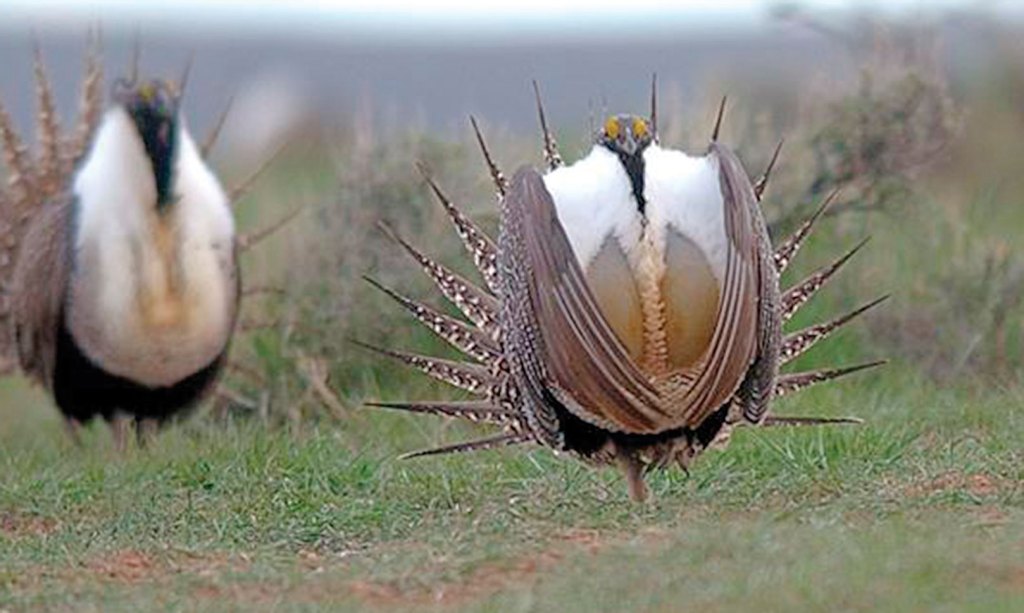County gets $1.7M to help sage grouse
Published 12:00 am Wednesday, January 23, 2019

- Sage grouse males inflate their air sacs during the spring mating ritual.
The campaign to aid Baker County’s struggling sage grouse population has received a nearly $2 million boost.
And that might just be the start of a multimillion-dollar effort to not only protect the chicken-size bird but also to improve the condition of rangeland, much of it privately owned, across the county.
The $1.7 million award from the Oregon Watershed Enhancement Board, approved last week, is the first installment in a planned $6.2 million from the Board, which receives its money from the Oregon Lottery, over the next six years.
Local officials also hope to use the state money to leverage federal grants and other sources that could make available several million dollars more to combat invasive weeds, deal with predators and do other work to aid sage grouse recovery, said Mark Bennett, a Baker County commissioner and a member of the governor’s sage grouse council.
“It’s really exciting,” said Bennett, who also owns a ranch in the southern part of the county that harbors sage grouse.
“We will be able to make a difference, a critical difference, and primarily on private land,” he said.
More than 70 percent of the sage grouse habitat in Baker County’s PAC — Priority Area for Conservation — is on private property, he said.
The ultimate goal, Bennett said, is to improve the health of the county’s hundreds of thousands of acres of rangeland, something that has the potential to benefit not only the sage grouse and other species but also the productivity of cattle ranches, which are a bulwark of the county’s economy.
“This is going to pay dividends not only for the bird, but for the grazing community, recreation, the watershed,” Bennett said.
The sage grouse has been what Bennett calls the “sentinel species” for the condition of those rangelands for more than a decade.
Baker County’s sage grouse situation is unique in Oregon in that the majority of the bird’s habitat here is on private property. Baker County is at the northern fringe of the sage grouse’s range in Eastern Oregon, and the county’s sage grouse population accounts for less than 10 percent of Oregon’s total.
Most of the bird’s habitat and population in the state are in the southeastern counties of Lake, Harney and Malheur, which are predominantly public land.
Environmental groups have repeatedly asked the federal government to classify the bird as a threatened or endangered species, a decision that could curtail activities, including cattle grazing on public land, that could degrade sage grouse habitat.
In September 2015 the U.S. Fish and Wildlife Service decided not to list the bird as threatened or endangered.
But Bennett said the federal agency is slated to review the status of the sage grouse in 2020, and federal protection for the bird, and the possible effects on how public land is managed that could result, remains a possibility.
But rather than simply wait and accept whatever fate might bring, Bennett said a local group that includes landowners and officials from county, state and federal agencies has been working for years to study why Baker County’s sage grouse population has declined by about 70 percent over the past decade or so, and to consider ways to reverse that trend.
“We said if we don’t get out in front of this we could have a serious problem,” Bennett said.
The Oregon Watershed Enhancement Board grant reflects the work that has been done, he said, since proponents had to show the Board how the Lottery dollars would be used.
Bennett said Marisa Meyer, a wildlife biologist with the U.S. Fish and Wildlife Service in La Grande, and Nick Myatt, who manages the Grande Ronde Watershed District for the Oregon Department of Fish and Wildlife (ODFW), were instrumental in starting the Baker Sage Grouse Local Implementation Team that applied for the Lottery dollars.
Myatt said the grant is a “huge influx of money into the county for private landowners and livestock producers for doing the work we want to do for sage grouse habitat restoration.”
Bennett said the Tri-County Cooperative Weed Management Area, which covers Baker, Union and Wallowa counties and is a core member of the local team, will be the fiscal agent for the money.
A committee from the Sage Grouse Local Implementation Team will review applications from landowners for grants and distribute the Lottery money, Bennett said. That committee includes representatives from Baker County, the U.S. Fish and Wildlife Service, ODFW and the U.S. Natural Resources Conservation Service, he said.
See more in the Jan. 21, 2019, issue of the Baker City Herald.





